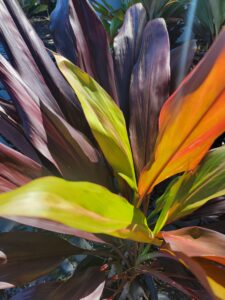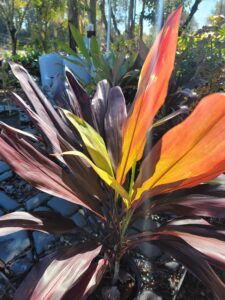S & J Nurserys Guide to Growing
Cordyline / Hawaiian Ti ‘Black Majic‘
in the Northeast Florida Landscape
Cordyline fruticosa ‘Black Majic’
Cordyline fruticosa ‘Black Majic’ Origins:

– Cordyline fruticosa or Hawaiian Ti plants are members of the Agavaceae family
making them relatives of both Agave and Yucca plants. Cordyline plants are native to Southeast Asia and New Guinea.
– Hawaiia Ti Black majic is grown for its uniquely colored foliage that emerges bright green and matures to a deep rich purple black.
Cordyline plants are considered a tropical plant, thriving year round in zones 9B-11 and frost sensitive in zone 9a here in Northeast Florida you may need to protect these plants from frosts during winter.
Preferred Exposure of the Hawaiian Ti Black Majic :
– Hawaiian Ti ‘Black majic can be planted in a full sun to partially shaded location in the North Florida | Jacksonville | St. Augustine area landscape. I feel they are at their best in a partially shaded location in our area, especially during those long hot summer days. Ideally morning sun with afternoon shade gives you a good balance as does the dappled shade near larger growing trees and palms Additionally shaded areas have better winter protection!
A word of caution to this tale….often these plants are shade grown at the wholesale nurseries down in south Florida and when you try to put them directly out into the sun they suffer some leaf scorch, although they recover quickly they may need a bit of time to acclimate to the sunnier locations of your landscape.
Foliage of the Hawaiian Ti Black Majic Plant:
– Large bold straplike foliage emerges from the center at the branch tips as a bright green and matures to an almost purple black. The darkest of the cultivars I have seen yet.
– Foliage may remain evergreen during the winter in our Northeast Florida area gardens, or may cold damage when temperatures reach below 32 degrees.
Soil Preference / Salt tolerance of Foliage of the Black Majic Plant:
– Cordyline plants prefer moist but well draining soils that are rich in organic matter so amend your planting hole generously when planting into our Northeast Florida landscapes.
– Poor salt tolerance.
Size Variance of Foliage of the Cordyline / Hawaiian Ti ‘Black Majic’ Plant:
– A larger growing selection that reaches 6-8 ft in height and 2-3 ft wide in our subtropical climate zone here in Northeast Florida landscapes.
Growth Rate:

– Expect this one to reach its full size potential around the second to third year in the landscape. You should get 6-12 inches in growth in the first year.
Water Requirements of Hawaiian Ti Black Majic:
– Although much more durable once established in the landscape, regular water is necessary to get the plant rooted and growing on it’s own after being planted in the ground from an S & J Nursery container. Water every day for the first week then every other day for the next week, and continue to taper watering black to a minimum of once a week.
– Use supplemental irrigation once to twice a week after the plant is established and growing in the landscape especially during the hot summer months. Cordyline plants have a tendency to experience damage to the foliage during prolonged exposure to drought.
Best Use for the Cordyline fruticosa Hawaiian Ti Black Majic Plant in the Jacksonville | St. Augustine Area Landscape:
– Hawaiian Ti Black Majic is a really showy plant that grabs attention at a distance making it the perfect tropical accent anywhere you want to draw the eye to in the landscape.
-Perfect for mixing among other flowering plants in the perennial border or container planting.
– Beautiful when planted in groupings around a palm tree, bird bath,
fountain or other garden accents.
– Easy care plant for containers on pool decks, patio areas, walkways, home
entry accents etc.
– Great indoor planting.
Care of Cordyline Hawaiian Ti Black Majic in the Northeast Florida Landscape:
– Amend the soil generously with compost at planting time to ensure that the plant will have moist but well draining soils.
– If planting Cordyline into flood prone areas or areas that hold water after heavy rains, be sure to plant them into an elevated mound of soil to let the roots get air during storm season. Just 4-6 inches above grade can keep your plants beautiful in these areas instead of watching them suffer.
– Water every day during the establishment period after planting in the garden from an S & J Nursery container.
-Trim off cold damaged foliage and stems in spring after all danger of frost has passed.
Fertilize with a slow release garden food like Osmocote directly after spring pruning and again in summer.

